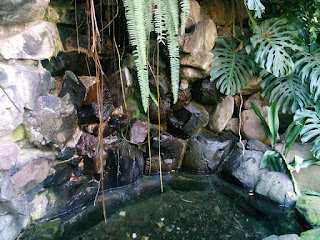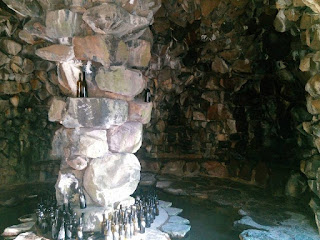ESTUFA FRIA DE LISBOA
(COLD GREENHOUSE OF LISBON)
THE HISTORY
On the grounds where nowadays lays the "Estufa Fria" (Cold Greenhouse of Lisbon) complex, it existed before, on the turning of the XIX century, a quarry from where basalt was extracted. Due to the existance of a water stream that turned impracticable the rock extraction, the querry ceased labouring.
The quarry pit was then used by a humble gardener to shelter botanical species from all around the wolrd, that would be soon used in the arborization plan of the nearby avenue "Avenida da Liberdade". The First Wolrd War slowed down this plan and plants started growing their roots arround this sheltered place.
In 1926, the painter and architect Raul Caparinha, after discovering this pleasant green area, idealised a project to transform it in the Greenhouse, which was concluded in 1930 and had the official opening three years later.
During the 40's, the whole "Parque Eduardo VII" park suffered changes, adopting the shape that we nowadays recognise. The "Estufa" was no exception and, besides the entry remodelling and new framing, was created the borderline lake and a huge room underneath the park's grove, the inner room "Nave", used during several years as Municipal Theatre. Nowadays, is sometimes used for entertainment and cultural events.
In 1975 was the opening of "Estufa Quente" (Warm Grennhouse) and "Estufa Doce" (Sweet Greenhouse), original idea of Engineer Pulido Garcia, voted to permanet exhibition of tropical and equatorial plants.
THE GREENHOUSES
"Estufa Fria" isn't only one greenhouse, but three different ones, that occupy about one and a half hectare of land nearby the "Parque Eduardo VII".
The "Estufa Fria" (Cold Greenhouse) itself occupies 8.100 square meters. Initisally idealised as a shelter for plants (the greenhouse terminology can be use in this sense), this greenhouse always kept its function, while it gathered magnificent botanical spoil, from all corners around the world.
The name Cold Greenhouse results from the fact that it doesn't use any warming system at all. The different characteristics of the other greenhouses (both destined to more exotic plants), with glass roofing and higher temperatures, distinguishes them as warm greenhouses.
The wooden lath roofing which covers the "Estufa Fria", replacing the old wooden blids once used, aims to protect the plants from the winter inclemecy and the heat of summer. These attached laths are conditioners of light intensity, providing an ideal temperature for the development of plants from several countries and world regions like China; Australia; Mexico; Peru; Brazil; Antilles; Korean Peninsula, among many others.
Inside the "Estufa Quente" (Warm Greenhouse), in a 3.000 square meters in area, mingle several tropical plants such as the Coffee plant (Coffea arabica); the Mango tree (Mangifera indica) or the Bananas (Musa spp).
The "Estufa Doce" (Sweet Greenhouse), the smallest of all, with only about 400 square meters, is the Cactaceae home. Here we can find the succulent plants, so-called due to their thick leaves and jelly-alike concistence. The Cctus are their most commonly know members. It's worth seeing the shapes of Golden barrel (Echinocactus grusonii), of Silver torch (Cleisticactus strausii) or Bitter aloe (Aloe vera).
It's also worthwhile to point out the advantage taken from many stones that ornament the "Estufa" and are integral part of the stairs, waterfalls and small pounds, resulting from the basalt quarry that once existed.
Among the vegetation it's possible to discover some statuary pieces that enhances the charm of this truly "vegetal museum" where time goes by slowly and pleasently.
Informations about the Estufa Fria:
Opening times:
Summer Season: 9h - 18h (after March's last weekend);
Winter Season: 9h - 17h (after October's last weekend).
Last admission: 30 minutes before closing time.
Open everyday except 1st January, 1st May and 25th December.
How to get there
Subway:
"Parque" Station (Blue line)
Exit towards: Parque Eduardo VII; Av. Fontes Pereira de Melo; Av. António Augusto de Aguiar; Av. Sidónio Pais.
"Marquês de Pombal" Station (Yellow and Blue line)
Exit towards: Av. António Augusto de Aguiar; Parque Eduardo VII; Praça Marquês de Pombal; Rua Braancamp.
Bus:
12; 22; 36; 44; 702; 720; 745
Bus stop: Marquês de Pombal





































